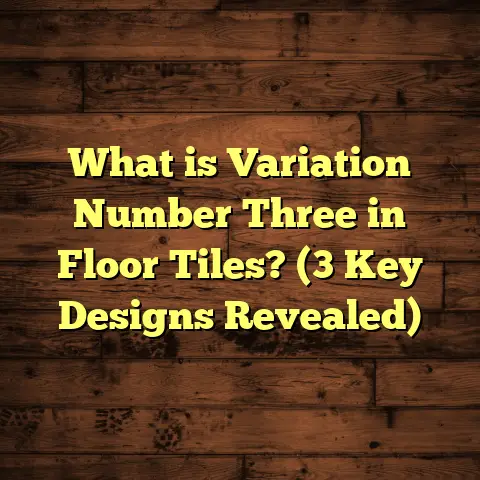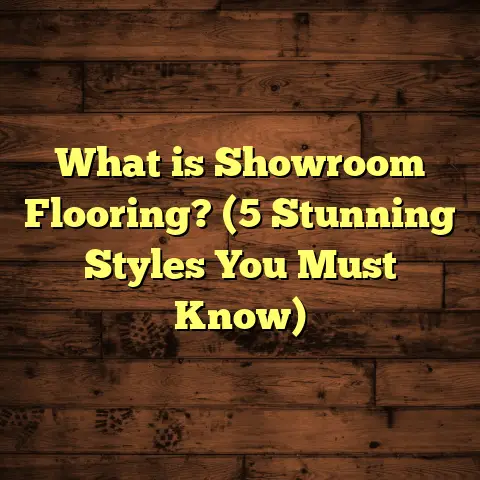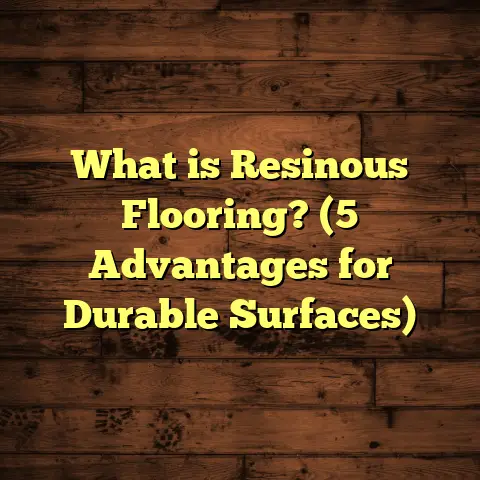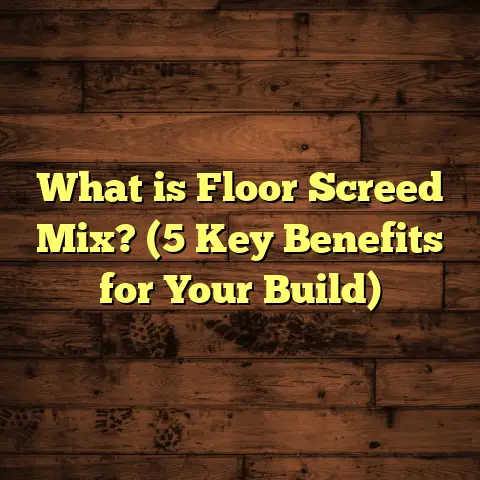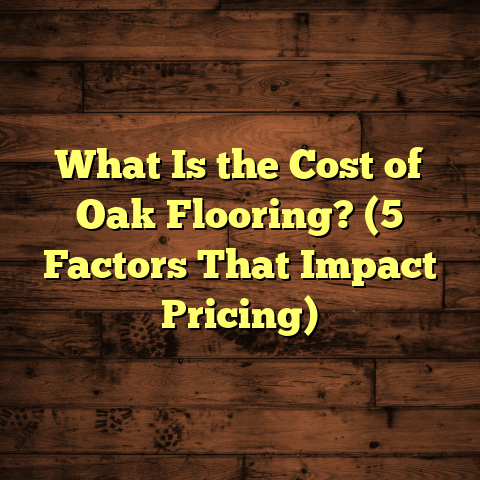What is an Engineered Wood Floor? (5 Benefits You Didn’t Know)
I once tried to install an engineered wood floor all by myself. I figured, “How hard can it be? It’s just wood, right?” Well, let’s just say the floor looked less like a professional job and more like a piece of modern art… abstract and unintentional. But along the way, I learned a ton about engineered wood floors. More than that, I found out why this type of flooring has quietly become one of the most popular choices for homeowners, contractors, and designers alike. Curious? Let me tell you everything I’ve picked up about engineered wood floors—starting with what they really are—and share five benefits that might surprise you.
What Is Engineered Wood Flooring?
You might have heard of hardwood floors and laminate floors, but engineered wood flooring is somewhere in between—and yet totally unique. Imagine a layered cake made of wood. The top “slice” is a thin layer of real hardwood—oak, maple, or walnut—giving you that authentic wood look and feel. Below this veneer are several layers of plywood or high-density fiberboard (HDF), glued together with grains running in alternating directions. This cross-layered construction is what gives engineered wood its stability.
Why does this matter? Because solid hardwood planks—those made from a single piece of wood—have a tendency to expand and contract with changes in humidity and temperature. That expansion can lead to gaps, warping, or even cracking over time if the environment isn’t just right. Engineered wood floors resist these problems thanks to their layered structure.
I remember working on a project in a coastal home where the salty air and humidity wreaked havoc on a solid hardwood floor installed previously. After replacing it with engineered wood flooring, the clients were amazed how the floor held up without visible gaps or buckling through wet seasons.
The Layers Explained
Let’s break down those layers a bit more:
- Top Veneer Layer: This is real hardwood, typically between 1mm and 4mm thick. The species of wood here determines the color, grain pattern, and overall look.
- Core Layers: Usually made from plywood or HDF, these layers are stacked with grains running perpendicular to each other. This cross-grain structure adds strength and prevents the floor from bending or twisting.
- Bottom Layer: The base layer provides additional stability and supports the core layers.
This construction allows engineered wood floors to offer many of the aesthetic qualities of solid hardwood but with extra durability and flexibility.
Thickness and Wear Layer Details
One question I get often is: “Will the thin top layer wear out quickly?” It’s a valid concern. The wear layer thickness varies widely:
| Wear Layer Thickness | Refinishing Potential | Typical Uses |
|---|---|---|
| 0.6 – 1 mm | Usually cannot be sanded/refinished | Budget engineered flooring |
| 2 – 4 mm | Can be sanded 2-3 times | Mid to high-end residential applications |
| 5+ mm | Can be sanded multiple times (like solid hardwood) | Premium engineered flooring |
If you’re investing in engineered wood with refinishing in mind, look for at least 2 mm of wear layer.
Benefit #1: Handles Moisture and Temperature Like a Champ
If you live somewhere with changing seasons or higher humidity levels, you know how frustrating hardwood floors can be. One winter they’re snug, next summer they’re cracking apart. Engineered wood floors handle moisture swings much better due to their layered build.
Why Does Engineered Wood Resist Moisture Better?
When I worked on a lakeside cabin with large windows facing water and frequent morning fog, solid hardwood wouldn’t last a season without warping. We switched to engineered wood with a moisture-resistant finish and noticed minimal movement over two years despite extreme humidity changes.
How Much Less Movement?
In numerical terms:
- Solid hardwood can expand/contract roughly 1/4 inch across a 4-foot plank during seasonal shifts.
- Engineered wood might only move about 1/8 inch under similar conditions.
This kind of stability means fewer gaps at seams and less risk of cupping or crowning.
Real-Life Case Study: Basement Installations
Basements are notorious for being damp and cold—conditions where solid hardwood is not recommended at all. In one project I managed for a family renovating their basement into a media room, we chose engineered maple flooring glued down over a moisture barrier.
After three years, their floor still looked flawless, despite occasional minor water seepage from outside during heavy rains. The client was thrilled because they wanted the warmth of wood without worrying about damage from the basement environment.
Benefit #2: More Flexible Installation Options
One thing I love about engineered wood floors is how adaptable they are in installation methods. This is where they really shine compared to solid hardwood.
Floating Floors: Quick and Easy DIY Installation
Floating floors are installed without glue or nails—they literally “float” over the subfloor. Engineered wood planks click together via tongue-and-groove systems.
I installed these myself once in a small guest room over concrete slab flooring. It took me less than two days total, and the floor felt sturdy and looked amazing.
Floating floors are perfect for DIYers or rental properties where you want to avoid permanent installation.
Glue-Down Installation: Great for Concrete Slabs
You can glue engineered wood directly onto concrete slabs—something you simply can’t do with solid hardwood because it needs to breathe or be nailed down onto plywood.
This method offers excellent stability and soundproofing but requires professional adhesive application. I’ve done glue-down installations in urban condos where space is tight and noise control is essential.
Nail-Down Installation: Traditional Method Still Used
For those who prefer traditional installation, engineered wood can also be nailed or stapled onto plywood subfloors. This method offers a permanent fix with strong hold and minimal movement.
Benefit #3: Cost-Effective Without Sacrificing Style
You might wonder if engineered wood flooring sacrifices beauty to save money. Not true at all! Many brands offer stunning finishes and wide plank sizes that rival even high-end solid hardwood.
How Engineered Wood Saves You Money
Since only the top layer is made from expensive hardwood species, manufacturers can use less costly plywood cores underneath. This means:
- Lower material costs.
- Less waste since veneers are thin.
- Easier shipping (lighter weight).
Price Comparisons
Here’s what you might expect on average (prices per square foot):
| Flooring Type | Average Cost (Material + Installation) |
|---|---|
| Engineered Wood | $6 – $12 |
| Solid Hardwood | $8 – $15+ |
| Laminate | $2 – $5 |
| Vinyl Plank | $3 – $7 |
While laminate and vinyl are cheaper options, they don’t replicate the authentic look or feel of wood as well as engineered wood does.
Style Variety
If you’re picky about design—and many people are—you’ll find almost every type of wood species available as an engineered product:
- Classic oak in natural or stained finishes.
- Exotic Brazilian cherry or tigerwood.
- Distressed or hand-scraped textures for rustic looks.
- Wide planks for modern aesthetics.
A client of mine recently went for a dark-stained hickory engineered floor with wire-brushed texture that looked so good I had to do a double take!
Benefit #4: Durability That Lasts Decades
People often assume thinner wear layers mean engineered wood doesn’t last long—but that’s not true when you invest in quality products.
How Durable Is Engineered Wood?
With wear layers between 2-4 mm thick, most engineered floors can be sanded and refinished two or three times over their lifespan. That’s enough to keep them looking fresh for decades if properly maintained.
I worked on a historic home renovation where the original engineered floor was over 20 years old—it had been refinished twice already and still looked fantastic.
Scratch Resistance and Finishes
Modern engineered floors come with advanced finishes like aluminum oxide coatings that resist scratches and wear better than traditional polyurethane finishes.
Some brands even offer matte or hand-scraped finishes that hide dirt and minor scratches beautifully—great for homes with kids or pets.
Real Data on Longevity
A survey from Flooring Today showed:
- 70% of homeowners reported satisfaction with their engineered floors after 10+ years.
- Many floors lasted up to 30 years with regular maintenance.
That’s comparable to many solid hardwood installations.
Benefit #5: Eco-Friendly Choice for Conscious Consumers
If you care about sustainability—and who doesn’t?—engineered wood flooring offers several green advantages worth mentioning.
Less Demand on Slow-Growing Timber
Because only a thin veneer is used on top, engineered flooring consumes less slow-growing hardwood per square foot compared to solid planks.
The plywood core often includes fast-growing species like pine or poplar—or recycled wood fibers—reducing environmental impact.
Certifications Matter
Look for products certified by organizations like:
- Forest Stewardship Council (FSC)
- Programme for the Endorsement of Forest Certification (PEFC)
These certifications ensure materials come from responsibly managed forests.
Embodied Carbon Reduction
A case study from Green Building Advisor showed that using engineered wood flooring reduced embodied carbon emissions by around 30% compared to traditional solid hardwood floors.
In my experience working with eco-conscious clients, engineered wood often fits their goals better without compromising on style or performance.
Personal Stories & Lessons Learned
Let me share some stories that helped shape my perspective on engineered wood floors:
- The Flooded Kitchen: A client once had their kitchen flooded due to a pipe burst. They had solid hardwood floors that buckled badly and needed full replacement. When we installed engineered oak afterward, it survived smaller water spills much better and didn’t warp.
- The Mountain Cabin Radiant Heat: Radiant heat systems pose challenges for flooring because heat causes expansion. On this project, only engineered floors were viable—and three years later, no cracks or gaps appeared.
- The Rental Property Landlord: A landlord asked me for durable flooring that tenants wouldn’t ruin easily but still looked upscale. Engineered floors with scratch-resistant finish were perfect—they cut down on wear costs drastically over five years.
Common Questions About Engineered Wood Floors
Q: Can I install engineered wood over concrete?
Yes! Engineered wood is ideal over concrete slabs when glued down or floated over an underlayment designed for moisture control.
Q: How do I maintain engineered wood floors?
Regular sweeping or vacuuming plus occasional damp mopping with manufacturer-recommended cleaners keeps them looking great. Avoid excess water which can damage the veneer layer.
Q: Can engineered wood be refinished?
Yes—depending on wear layer thickness. Thicker veneers (2 mm+) allow sanding/refinishing 2-3 times; thinner veneers usually cannot be refinished.
Q: Is engineered wood noisy underfoot?
If installed as a floating floor without proper underlayment, it can feel hollow or noisy. Using quality underlayment reduces sound transmission significantly.
Final Thoughts From My Experience
After years in flooring installation and consulting, I can tell you that engineered wood flooring is often one of the best choices for combining beauty, durability, flexibility, and cost-efficiency. Whether you’re upgrading your living room or remodeling an entire home, it’s worth considering seriously.
The benefits—from moisture resistance to eco-friendliness—make it more than just a “compromise” between laminate and solid hardwood; it’s an excellent option in its own right.
Ready to explore specific brands or need help selecting the right type for your space? Feel free to reach out—I’m here to help turn your flooring dreams into reality without headaches along the way!
If you want me to add detailed brand recommendations or step-by-step installation guides next, just say the word!
